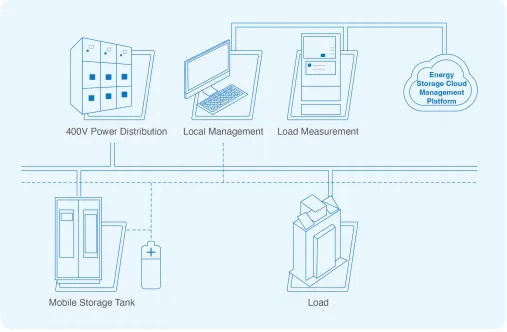
7月 . 03, 2025 14:03 リストに戻る
Energy Management System Battery Storage for Renewable Integration
As the world accelerates its transition to sustainable energy models, エネルギー管理システム (EMS) have emerged as critical facilitators in bridging the gap between renewable energy potential and practical application. At the forefront of this innovation lies energy management system battery storage, a technology designed to address the inherent intermittency of wind and solar power while optimizing electrical grids for efficiency. This article explores how these integrated solutions are reshaping renewable energy integration, enhancing grid resilience, and driving long-term sustainability—all while delivering tangible benefits to transit networks, utilities, and commercial operations.

The Critical Role of Energy Management Systems in Renewable Integration
Energy management systems serve as the strategic hub for coordinating energy flow across complex networks, particularly when integrating variable renewable sources. By aggregating real-time data on energy production, consumption patterns, and grid conditions, these systems enable proactive adjustments that balance supply and demand. For example, during periods of low solar irradiance or calm winds, an EMS can automatically draw from stored energy reserves or redirect power from alternative sources to maintain consistent service—eliminating the risk of outages that plague unmanaged renewable setups.
Beyond reactive control, modern エネルギー管理システム leverage predictive analytics to anticipate energy needs. By analyzing historical weather data, user demand trends, and equipment performance, they optimize the scheduling of renewable energy generation and storage usage. This foresight reduces reliance on fossil fuel backup systems, lowers operational costs, and ensures that every kilowatt-hour of renewable energy is utilized efficiently. For transit agencies transitioning to electric fleets, this means reliable power supply even when renewable production fluctuates, keeping buses and trains on schedule while minimizing carbon emissions.
Enhancing Grid Resilience with Energy Management System Battery Storage
The true power of renewable integration lies in the synergy between energy management system battery storage and intelligent control software. These storage solutions act as dynamic buffers, capturing excess energy generated during peak renewable production (such as sunny middays or windy nights) and releasing it when demand surges or generation lags. Unlike traditional battery setups, which operate in isolation, EMS-integrated storage systems benefit from real-time monitoring and adaptive charging algorithms that maximize battery lifespan while optimizing energy throughput.
In urban transit networks, this technology transforms how electric vehicles are powered. By storing off-peak renewable energy (e.g., solar power generated during the day but unused at night), energy management system battery storage enables overnight charging of bus fleets at lower grid rates, reducing operational expenses. During peak hours, these systems can also feed stored energy back into the grid, stabilizing voltage levels and alleviating congestion—a service that utilities often compensate for through demand response programs. The result is a more resilient grid that can withstand supply fluctuations, support growing electrification demands, and reduce dependence on non-renewable backup sources.
Holistic Efficiency with Electrical Energy Management System Frameworks
A electrical energy management system takes integration a step further, unifying renewable generation, battery storage, and end-user consumption into a single, cohesive ecosystem. These frameworks are designed to optimize energy flow across diverse applications, from public transportation networks to commercial buildings, by treating the entire system as a unified entity. For instance, an EMS overseeing a city’s transit grid can balance energy distribution between electric buses, streetlights, and station infrastructure, ensuring no resource is wasted while prioritizing critical loads.
One of the standout advantages of electrical energy management system frameworks is their ability to support multi-directional energy flow, including vehicle-to-grid (V2G) and grid-to-vehicle (G2V) interactions. Electric buses equipped with bidirectional chargers, for example, can not only draw power from the grid but also return excess stored energy during periods of high demand, effectively turning vehicles into mobile energy storage units. This circular energy model enhances the utilization of renewable resources, reduces peak load stress, and creates new revenue streams for operators. By eliminating silos between energy production, storage, and consumption, these systems drive efficiency gains that traditional setups simply cannot match.
FAQ: Unlocking the Value of Energy Management System Battery Storage
How do energy management system battery storage solutions boost operational profitability?
By optimizing renewable energy usage and minimizing grid dependency, these systems significantly reduce energy costs. Predictive load balancing ensures energy is sourced when prices are lowest—such as during off-peak hours—while excess renewable energy can be stored for later use or fed back into the grid for compensation. Additionally, extended battery lifespan due to intelligent charging cycles cuts maintenance expenses, delivering a robust return on investment over time.
What ensures energy management system battery storage outperforms traditional standalone batteries?
The difference lies in integration: these systems work hand-in-hand with エネルギー管理システム to analyze real-time data, adjust charging parameters, and prevent overloading. This symbiotic relationship ensures batteries operate within optimal performance windows, avoiding damage from sudden voltage spikes or deep discharges. The result is a more reliable, longer-lasting storage solution tailored to the dynamic needs of renewable energy grids.
Can a electrical energy management system integrate with existing infrastructure?
Absolutely. Modern systems are built with modular, scalable architectures that seamlessly interface with both legacy equipment and new technologies. Whether retrofitting a decades-old transit network or upgrading a commercial facility, these solutions adapt to existing setups, ensuring a smooth transition without service disruptions. Open communication protocols allow for gradual upgrades, making them ideal for organizations prioritizing phased sustainability investments.
How electrical energy management these systems advance long-term sustainability goals?
Energy management system battery storage そして electrical energy management system frameworks are central to decarbonization efforts. They enable higher penetration of renewable energy by addressing its intermittency, reduce fossil fuel consumption through efficient load balancing, and provide the data transparency needed to meet strict emissions targets. For transit agencies and enterprises, this translates to measurable progress toward net-zero commitments while enhancing public trust in sustainable operations.
What support is available for implementing energy management system solutions?
End-to-end support is standard, from initial system design to ongoing optimization. Expert teams collaborate with clients to assess unique needs, customize configurations, and ensure seamless deployment. Post-installation, 24/7 monitoring and adaptive software updates keep systems performing at peak efficiency, while dedicated support teams address any operational questions. This comprehensive approach minimizes downtime and maximizes the value of your energy infrastructure investment.
As the global push for renewable energy intensifies, energy management system battery storage and integrated electrical energy management system frameworks stand as indispensable tools for unlocking its full potential. By combining intelligent control, resilient storage, and holistic network optimization, these solutions not only overcome the challenges of renewable intermittency but also deliver tangible benefits in cost savings, operational reliability, and environmental stewardship. For any organization aiming to future-proof its energy strategy, the choice is clear: embrace integrated energy management to power a sustainable, efficient, and resilient future.
-
Smart Grid Management for Rural Electrification
ニュースJul.03,2025
-
Energy Management System Battery Storage for Renewable Integration
ニュースJul.03,2025
-
Energy Control Systems in Public Transportation Networks
ニュースJul.03,2025
-
Electrical Energy Management System for Electric Vehicle Charging
ニュースJul.03,2025
-
BMS Energy Retrofitting for Aging Infrastructure
ニュースJul.03,2025
-
Adaptive Energy Control Systems for Weather Variability
ニュースJul.03,2025























